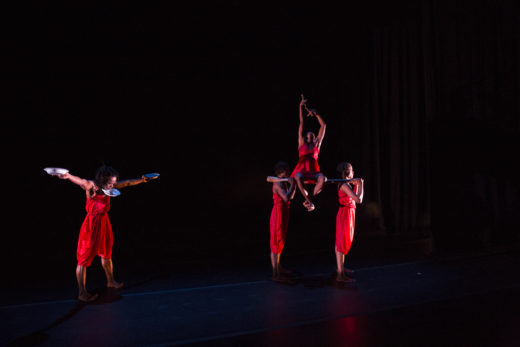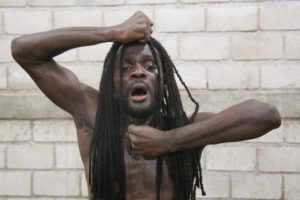Jeanguy Saintus: Contretemps
Catherine Annie Hollingsworth

Ayikodans at the Adrienne Arsht Canter for the Performing Arts, 2016, photo by Daniel Azoulay
In Miami, we’re fortunate to get a first look at most of his work. Ayikodans has maintained an ongoing partnership with the Adrienne Arsht Center for the Performing Arts, and the company performs here annually. Saintus typically offers a master class for local dancers. From this vantage point, as a student in the dance studio, the details of his choreographic approach come into focus: he obsesses over hands, feet, and eyes while expecting performance of the highest order from the dancers and drummers who travel with him. Saintus’s way of holding space in the studio is strikingly elegant, and his work is an uncommon blend reflecting his training: classical ballet, modern technique, contemporary, and what he consciously calls “traditional” dance.
“I’m lucky enough to know my traditional dances, the rhythm, and the lwa [the spirits of Haitian vodoun],” he says. “Fortunately or unfortunately, our traditional dances are related with the religion.” For Saintus, the word “traditional” makes a precise statement, positioning him in a specific orientation within Haitian dance culture. The more commonly used word for Haitian traditional dance is “folklore.” Outside the orbit of Haitian dance, folklore refers to storytelling—but where Saintus is from, “Haitian folklore” is the generic term for the dances that come from Africa and have been handed down in both religious and performative zones.
In a way, Haitian folklore is storytelling through movement. It represents the lwa and histories of tribal culture, slave rebellion, revolution, and celebration. The dances and corresponding rhythms of folklore are taught in dance schools around the world, and students of the form know them by their individual names: yanvalou, nago, banda. On stage, the folkloric dances and rhythms are often intentionally separated from ritual meaning, transforming them into secularized representations of Haitian culture. Saintus sees folklore more as entertainment than art. “They always ask you to smile. People don’t always smile in our dances because it’s a ritual, a connection to the spirit. But when you are dancing for an audience, like a touristic audience, you want to show that you are happy.”

Ayikodans rehearsing at Artcho Danse in Port-au-Prince, Haiti, photo by Roberto Stephenson.
Because “traditional” describes something so distinct in Saintus’s lexicon, it refers to movement that relates to Haiti’s spiritual practices and culture, the creative work of an individual choreographer like himself—reflective of the traditions, but not imitative. “Staying true to myself and showing respect to the ritual and spirituality in the dance would be my take on ‘tradition.’”
His work has been questioned both inside and outside of Haiti. Sometimes, he says, “they are more comfortable with déjà vu. They want you to use flowers, colors and fake props to claim your blackness, your Africanism, or Caribbean soul.” He has been told that what he does is great, but “sometimes they decide what I’m doing is not Haitian enough, it’s not authentic.” The more authentic dancer, in such a person’s perspective, is the one closer to the source who remembers and re-transmits the original steps. There’s a song belonging to the dance and rhythm of ibo that communicates this sentiment: sim te la lè grann mwen te la, li ta montrem danse ibo. (If I was alive when my grandma was alive, she would have taught me how to dance ibo.)
Saintus has found that the Haitian dance community in Miami is particularly resistant to his pioneering approach. “What I see is that people are just comfortable with what they know.” In Miami, he says, “they left Haiti in 1957 or later, and they think here [in Haiti] we didn’t move. Everything stayed where they left it. But music, even in the ceremony, is evolving with time.”
He takes liberties with tradition, using music idiosyncratically. The rhythm for one dance may be paired with the movement of another. And sometimes he matches movements with drumbeats in an unconventional pattern. He refers to this approach as contretemps, a term borrowed from classical ballet. Contretemps translates literally from French as “against time.” According to Saintus, in contretemps “you don’t go exactly on the beat… you will find the rhythm at the end.” He uses stripped down isolations that draw from traditional forms without reproducing them in full: maybe he utilizes just the undulations of the arms in yanvalou, or only the pelvic winding from banda.
If Saintus meets with friction as an artist drawing from Haitian tradition, a counterforce is applied from the contemporary sphere. Though Ayikodans is celebrated, they are just as often relegated to an ethnic category or urged to adapt. Saintus’s use of music, spirituality, and traditional forms is out of alignment with the U.S. and European contemporary dance establishment, where music has become an accessory and rhythm has been stripped away. Even the physicality of dance technique can fall outside the lines of contemporary conventions.
While contemporary dance is held as a kind of freedom from the confines of the past, it can be an ossified form with its regimented rule of no rules, or its sometimes rigid insistence on the conceptual. Saintus is not interested in conforming. “I’m here with you in 2016, very aware of everything going on around me, aware of everything that this body has in it,” he says. “How can I explain that this step is traditional and this step is contemporary?”
He recalls a workshop focused on moving in the dark. “I remember telling the guy I could stay in the hotel because I am from Haiti, where there was no electricity since I was young. I know how to move in the dark; I didn’t have to come all the way here to learn it.” Saintus also talks about choreographed falling in contemporary dance as something embedded in Haitian spiritual tradition. “In the trance [of vodoun ceremonies], fall and rebound is part of the process. When you feel the trance is coming, you let it go and you break it, you go into that fall and rebound process.” As Haitians, he says, “we find ourselves sometimes in studios learning things that we have in our traditional dances, as contemporary.” From Saintus’s perspective, US and European measures set the mark for what is new and what is not, serving as cultural validator.
The influence of dominant cultural standards can be measured in funding and performance opportunities. “They have theaters, huge networks in Europe. They even find their way to South America.” But Saintus holds firm. “I need the money, the tour, but I won’t sell my soul and be ashamed of my work.” Others may not be so willing to resist the pressure, not just in Haiti, but in other countries like Cuba where artists may see their craft as an opportunity to escape current circumstances. “Nowadays I am seeing lots of young Caribbean dancers entering the game just to get out,” he says. As for his own work, he prefers not to offer any categorical description. “I use my arms the way I feel; I don’t use them because this is the way they should be. I want you to feel your arms, to let them go… I think this is based on the liberty that we have to use our bodies the way we want. This is contemporary dance for me.”
Catherine Annie Hollingsworth is a Miami-based dance and performance writer.










